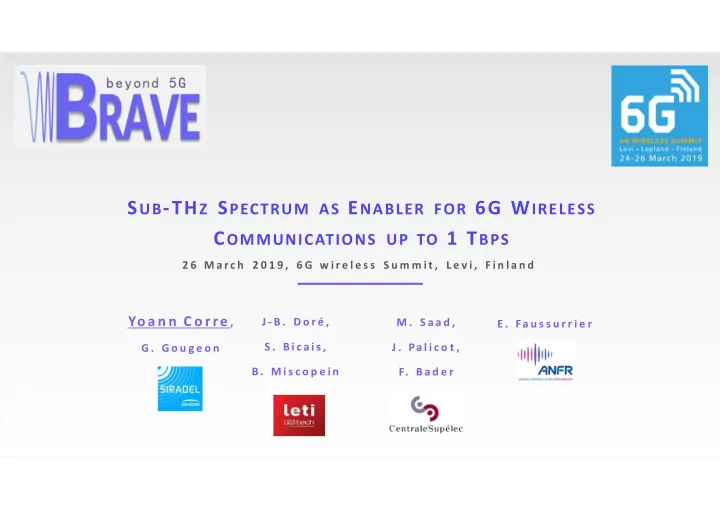

S UB -TH Z S PECTRUM AS E NABLER FOR 6G W IRELESS C OMMUNICATIONS UP TO 1 T BPS 2 6 M a r c h 2 0 1 9 , 6 G w i r e l e s s S u m m i t , L e v i , F i n l a n d Yo a n n C o r re , J - B . D o r é , M . S a a d , E . Fa u s s u r r i e r S . B i c a i s , J . Pa l i c o t , G . G o u g e o n B . M i s c o p e i n F. B a d e r
I NTRODUCTION Industry Spectrum regulator � BRAVE project Academic lab o Funded by French Research Agency (ANR) o 2018 - 2021 o 1.5 M€ � Explore new radio technologies Research lab (waveform, topology, …) to operate at frequencies above 5G spectrum 2 26 March 2019, 6G wireless Summit, Levi, Finland
S PECTRUM OPPORTUNITIES � Range of interest: [90 – 200] GHz � Today: mainly scientific services o Astronomy observations, Earth exploration, Sat communications, Meteorology… � Huge bandwidth potential o 58.6 GHz already allocated for fixed and mobile services by the Radio Regulation (RR) o W and D bands: Already some 100 GHz 120 GHz 140 GHz 160 GHz 180 GHz 200 GHz industrial interest, and CEPT recommendationsreleased 92 - 115 GHz 130 - 175 GHz D band W band 3 26 March 2019, 6G wireless Summit, Levi, Finland
E ARLY VISION FOR B5G SUB -TH Z COMMUNICATIONS 4
E ARLY VISION FOR B5G SUB -TH Z COMMUNICATIONS 5
D EFINITION OF SCENARIOS – O NE EXAMPLE : K IOSK Scenario parameters All scenarios described in BRAVE D1.0 System & performance requirements Restricted to DL DP at very-high data rate 6
T ECHNICAL C HALLENGES Technical PHY related challenges that are adressed by the project Model & simulate the radio propagation channel 1. Model & simulate RF impairments (typically: Phase noise, non-linearities) 2. Define & evaluate new appropriate waveforms 3. Define & evaluate efficient modulation and detection schemes 4. Assess the feasibility & performance of some applications 5. Demo 6. No hardware development Exploration step Evaluations are performed based on analytical studies & simulations 7 26 March 2019, 6G wireless Summit, Levi, Finland
P ROPAGATION CHANNEL MODELLING � Main channel properties (incl. MIMO)? � Communication ranges? � Isolation or Interference levels? � Impact of antenna beamwidth, mis-alignment, body blockage…? � Channel samples for design of new air interface 8 26 March 2019, 6G wireless Summit, Levi, Finland
P ROPAGATION CHANNEL MODELLING � ITU models for atmospheric effect, rainfall loss, materials, building entry loss, and vegetation loss � When needed: Frequency extrapolation used as a first approximation 9
P ROPAGATION CHANNEL MODELLING � Using Ray-based models o Today tuned in 5G mmWave bands � Get channel statistics and samples × Many Links Backhaul ray-paths @150 GHz Coverage map @150 GHz 10
P ROPAGATION CHANNEL MODELLING HPBW 20° NLoS Delay spread # @Low noise HPBW 6° Indoor ray-paths NLoS Delay spread # @High noise # Delay spread measured from 30-dB channelresponse range 11
S INGLE - CARRIER WAVEFORM Channel sparsity. � Why BRAVE decided to look at single-carrier waveforms? Narrow antenna beam. 1. Favorable propagation is expected (i.e. towards frequency flat) 2. Lower PAPR (Peak to Average Power Ratio) can be achieved Multi-carrier OFDM suffers from 3. Modulations robust to Phase noise can be implemented non-linear distortion and poor efficiency at HPA. 4. Adequate sub-band division to be found Efficiency of CMOS-based HPA decreases at higher frequencies. Phase Noise is due to non-stationarity in the Local Oscillator (LO), and becomes a Band-limited A2D. major limitation in sub-THz communications. � Revisiting 5G NR waveform is mandatory! 12 26 March 2019, 6G wireless Summit, Levi, Finland
E LABORATION OF ADEQUATE WAVEFORMS � Constant or near-constant envelop modulations o For instance: CPM (Continuous Phase Modulation) o At the cost of lower spectral efficiency (SE) o But compensated by Index Modulation (IM) e.g. Generalized Spatial Modulation (GSM) � SC + CPM + IM waveform � Balance between SE, EE, HW cost and detection complexity Phase trajectory GSM transceivers Q I 13
E FFECT OF THE PHASE NOISE (PN) VARIANCE � M-PSK regions vs SNR and Phase Noise � Accurate PN modelling ² variance � � Low PN Higher PN PSD of a 200 GHz oscillator
E FFECT OF THE PHASE NOISE (PN) VARIANCE � Modulations tailored for PN channel Coherent vs Non-coherent Polar receiver Higher PN Low PN 15
N EXT STEPS � Continue PHY modelling work � Consider realistic antenna capabilities � Plug together the PHY models and the proposed waveform/modulation schemes � Explore different operating modes o Ultra high data rate , at cost of complex architecture and heavy power consumption o Lower spectral efficiency , but compliant with low-cost low-power devices � Propose 5GNR waveform amendments compatible with sub-THz channel constraints 16 26 March 2019, 6G wireless Summit, Levi, Finland
j e a n - b a pt ist e. do re @ce a .f r Thank you for your attention { c a r l os , fa o u z i }. ba d er@s u pe le c.fr y c o r re @s irad e l.co m e m m a n u e l .fa us s uri er @a nfr.f r Visit our website: http://www.brave-beyond5g.com
Recommend
More recommend